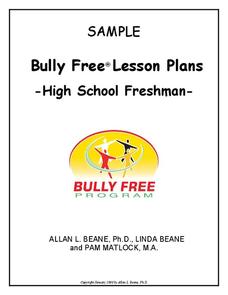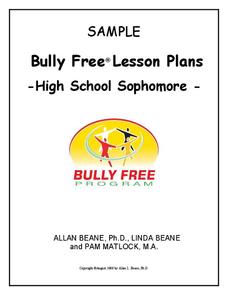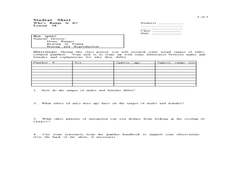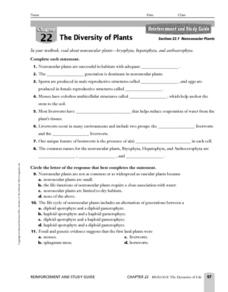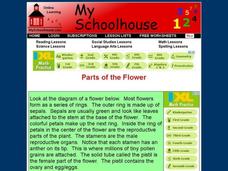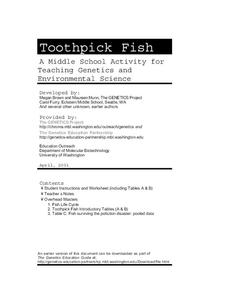Curated OER
Fantastic Flower
Here is a clever lesson on pollination of flowers for you. In it, learners study the anatomy of a flower, and play a game in which they simulate the process of pollination. This fine plan brings in elements of art, physical education,...
Curated OER
Stained Glass Flowers
Elementary and middle schoolers create decorative flowers using wire armatures and a special paint that remains flexible when it dries. The results from this project are stunning, but the materials needed may be tough to track down. An...
Curated OER
Pollination Power
Students go out into the garden and observe pollinating animals through hand lenses. In this pollination lesson plan, students also discuss how animals carry seeds to create new plants elsewhere.
Curated OER
Genetics Crossword
In this Mendelian genetics worksheet, students solve 22 clues in a crossword puzzle contain the basic vocabulary for an introductory genetics unit.
Curated OER
Endocrine System Crossword
In this endocrine system worksheet, students solve 12 clues in a crossword puzzle focusing on the organs and hormones of the endocrine system.
Curated OER
Anatomical Position & Directional Terms
Simple lists of anatomical terms fill the slides in this collection. It begins by explaining the general anatomic position and then goes into directional, body plane, and body cavity terms. The separate regions are categorized as head,...
Curated OER
Edible Bug Project
Students recognize the characteristics of insects. In this edible bugs lesson, students observe the body parts of an insect. Students create an edible insect using a grape, carrot sticks and sorrel stems and leaves. Students share the...
Garden Earth Naturalist Club
Parts of a Flower! Flower Dissection
Sometimes the best way to learn about plants is to see the different parts of a plant yourself. Groups of learners dissect flowers to answer questions about what they observe and what they wonder about their flower.
Virginia Department of Education
Meiosis
Intrigue the class by completing a lesson on meiosis, filled with challenging and insightful activities to spark the interest of every person in the room. Each member of the class learns about genetic disorders due to faulty meiosis, and...
Bully Free Systems
Bully Free Lesson Plans—Ninth Grade
"Bullying and Prejudice" and "Do You Cyber Bully," two lessons from a complete Bully Free program, serve as samples of the approach used in a unit designed to bring awareness to and to combat bullying. Each lesson asks class members to...
Bully Free Systems
Bully Free Lesson Plans—10th Grade
Two lessons, "What Does Cyber Bullying Look Like?" and "Factors Influencing My Reporting the Bullying of Others," serve as examples of the 12 included in a Bully Free curriculum. Each plan includes discussion questions, an activity, and...
Curated OER
Who's Range is it?
Students investigate the habits of panthers by analyzing radio transmitted data. In this animal life lesson, students utilize computers to view the range of different statistics dealing with Florida panthers. Students complete a...
Curated OER
Evolution of Plants
This is a wonderful PowerPoint! It gives excellent details of different types of ferns and their characteristics which help them to survive and produce spores in many varied habitats.
Biology Junction
Cnidarians and Ctenophorans
Cnidaria is a broad phylum of 11,000 different species from jellyfish to coral. Most Cnidarians are marine species with a few freshwater examples. A lesson presentation explains the important characteristics of different species of both...
Curated OER
COMMON KINDS OF INSECTS
Learners will recognize and name three common insects.1. Share background information with students. 2. Provide learners with the "bug body" puzzle pages, and have them cut the puzzles out.1. Share background information with students....
Curated OER
Non-Seed Vascular Plants
In this non-seed vascular plant worksheet, students review the characteristics of sporophytes, lycophytes, sphenophytes, and pterophytes. This worksheet has 19 fill in the blank, 4 true or false, and 2 short answer questions.
Curated OER
Segmented Worms
In this segmented worms worksheet, students will review the characteristics of segmented worms including the earthworm, bristleworm, and leech. This worksheet has 7 fill in the blank, 3 true or false, and 3 matching questions.
Curated OER
Nonvascular Plants
In this nonvascular plant worksheet, students compare the characteristics of bryophyta, hepatophyta, and anthocerophyta. This worksheet has 8 fill in the blank and 3 multiple choice questions.
Curated OER
Parts of the Flower
In this biology worksheet, students examine a diagram of a flower and read a selection that describes all of the parts including the petals, the stamen, the anther, and the sepals. They answer 11 on-line fill in the blank questions using...
Curated OER
Puberty
A simple cloze activity gets learners developing a comfort level with sexual development terminology. For Activity 1, they use 12 terms to fill in 11 blanks in an informational text, including sperm, eggs, sex hormones, puberty,...
Curated OER
The Purpose of Each Part of a Plant
Beginning botanists can sketch the parts of a plant in individual boxes, or better yet, they can tape or glue actual plant parts in them. Beside each box are a few sentences with selected words left out. From the word bank at the bottom...
University of Washington
Toothpick Fish
With colored toothpicks representing genes, youngsters practice passing them through generations of fish and learn about heredity. Consider this as an introductory activity since it does not represent recessive genes with lowercase...
Curated OER
Changing Bodies
Seventh graders listen to a poem about how a teen feels not understanding what is happening inside his body. In this health lesson, 7th graders label the endocrine glands and put sex characteristic cards in the order they think they...
Curated OER
The Physiological and Psychological Development of the Adolescent
Students examine the life of a teenager from their own perspective and an adult's. In groups, they focus on the biological changes and how they are different in a girl and a boy. Individually, they write a paper about these changes and...











